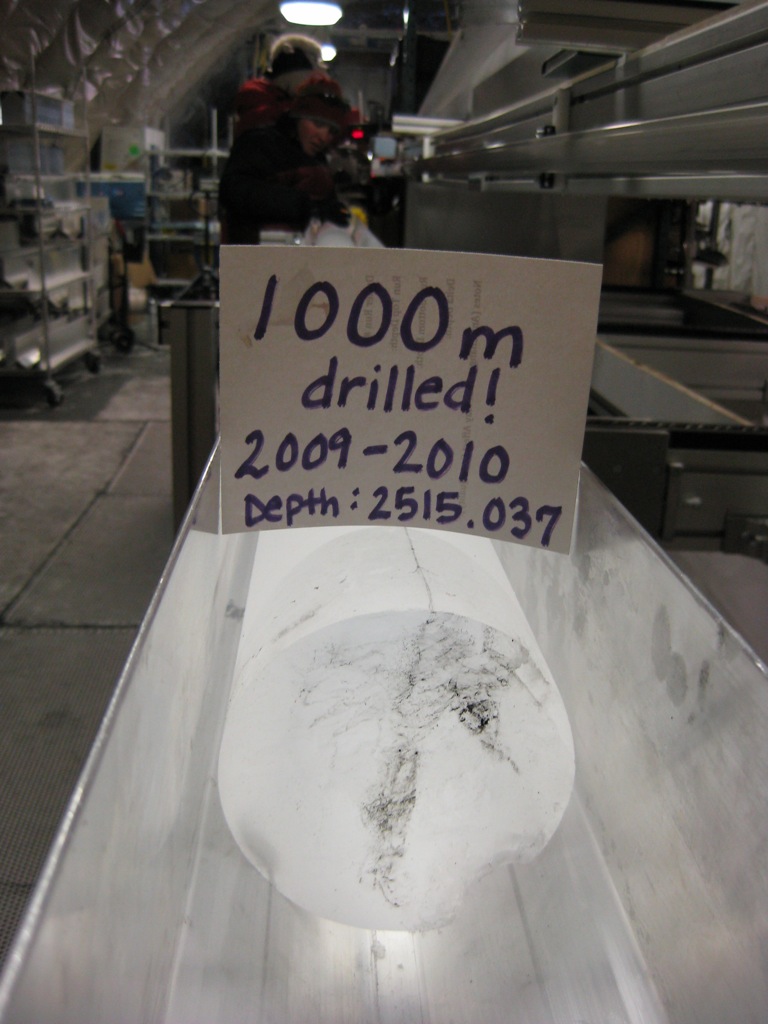
2009/2010 Field Season Review
CORE RECOVERY for the 2009/2010 drilling season ended as scheduled on January 25 at a bottom depth of 2560 meters. A total of 1049 meters of ice were drilled and the season's core quality was excellent with only a few mid-run breaks. In addition, the brittle ice drilled during the previous season had relaxed and was packaged and shipped to McMurdo Station prior to the start of the drilling season.
Drilling operations started on December 11 and routinely produced 30+ meters per day of perfect 3+ meter long cores. At these depths the gas bubbles have been forced into the ice lattice, making the ice almost glass clear and ductile. The cores occasionally had bands of volcanic ash, some razor sharp, others diffuse, which were a welcome treat.
After the ice was flown from WAIS Divide to McMurdo Station it was transferred into three new "SafeCore" freezer containers. The SafeCore containers were then transported from McMurdo Station to NICL. The SafeCore containers have backup cooling units in the event of a cooling unit failure. They also have generators on board in case of a power outage. We believe this was the safest transport of a deep ice core ever. The WAIS Divide community is sincerely grateful to Raytheon Polar Services Company and to the National Science Foundation for the procurement and funding, respectively, of the SafeCore freezer containers.
NICL Core Processing Line (CPL)
The NICL CPL began on June 2 this year. Start-up was slow, as to be expected, with new equipment going on-line and new workers on the line. NICL recruited excellent interns and Bruce Vaughn did a great job recruiting students to help out from UColorado. Geoff Hargreaves, as always, keeps things working and moving smoothly. Richard Nunn, brought over from the USGS Core Research Center, has come quickly up to speed on the database and is a pleasure to work with. The entire CPL crew is excellent and extremely capable.
So far we have processed 625 meters of ice. The current depth is 1202 meters, which means we're almost through the brittle ice zone and nearing the ductile ice. The netting applied in the field does an excellent job of keeping the ice intact. There are lots of breaks and spalls in the brittle ice, but for the most part the ice cores are holding together and don't just fall apart as the horizontal cuts are made. Last week we averaged ~30 tubes (~31 meters) per day.
Our goal is to reach 1300 meters by July 23 and we are on track to complete this milestone. On July 26 we plan to start the ductile ice processing where we hope to increase the production rate to 35 meters per day. Our hope is to process down to about 2030 meters by the end of this summer's CPL.
2010 Science Meeting
The 2010 WAIS Divide Ice Core science meeting will be held on September 30 and October 1 at the Scripps Seaside Forum in La Jolla, California. The meeting will have activities for all of both days and the evening of the 30th. Everyone associated with the project is encouraged to attend (PIs, technicians, students, field support staff, drillers, NICL, and Artist and Writers program participants).
We also currently have four "pre-meeting" meetings scheduled for Wednesday, September 29:
1-2 PM – WAIS Divide Borehole Logging (led by Gary Clow)
2-3 PM – WAIS Divide Replicate Coring (led by Jeff Severinghaus)
3-4 PM – WAIS Divide Executive Committee (led by Ken Taylor)
4-5 PM – Ice Drilling Program Office Planning Meeting (led by Mary Albert)
Full details about the meeting, including deadlines and the online registration form, can be found at:
http://www.waisdivide.unh.edu
2010-2011 Field Season
The 2010-2011 field season will be the fourth season of deep drilling with the DISC Drill. As usual, we will drill 24 hours per day, six days per week (Sundays off). We will resume drilling at 2560 meters depth and the goal for this season is to get to within ~70 meters of the bed at 3,330 meters. However, this is an ambitious goal that may require more time than is available due to the fact that we will be drilling in 'warm' (due to the geothermal heat flux that heats the ice sheet from below) basal ice.
Drilling in basal ice is challenging and a high risk. The heat from the drilling process is expected to melt some of the ice, which will refreeze on the drill and cause complications. Other warm ice drilling operations have temporary or permanently stuck drills, and produced core at rates of only a few meters per week. We are preparing for these complications by planning on using antifreeze compounds and having engineers experienced in warm ice drilling on site.
In addition to the new ice that will be drilled during the season, there are 530 meters of ice drilled during the 2009-2010 field season wintering over at WAIS Divide that will also be shipped back with the newly drilled ice cores.
